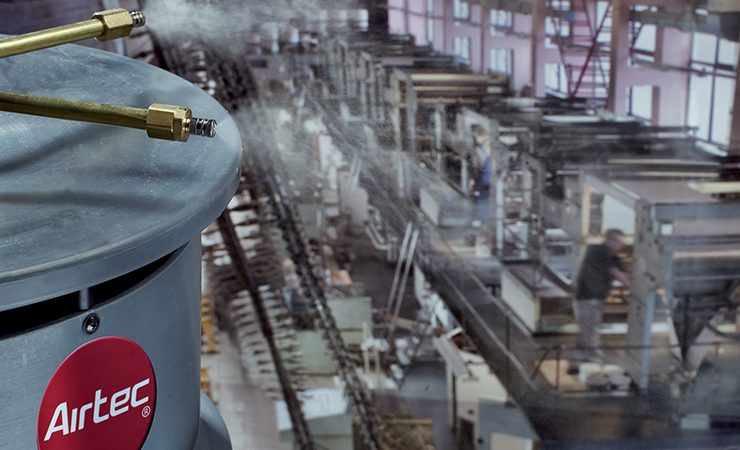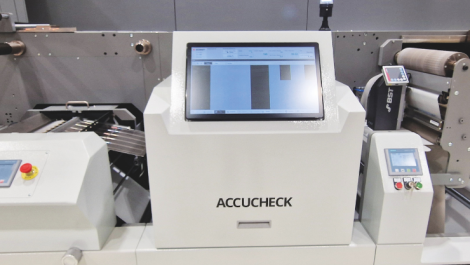While press technology inevitably takes centre stage in the pressroom, there are a number of additional technologies to ensure manufacturing remains efficient and productive.
Straight from when rolls and stacks of material enter a factory, they need to be stored and worked with in the correct environment. This makes humidity control one of the earliest considerations. Low humidity can draw moisture from paper, potentially causing curling, tight edges due to shrinkage, and build-up of electrostatic charge. These can reduce machine speeds and increase the risk of paper jams, and affect the quality of the final product. High humidity will similarly affect the performance of both paper and machines.
John Barker, managing director at Humidity Solutions, says that with companies investing thousands of pounds in printing and finishing equipment, and paper stocks, it makes sense to invest a little more to ensure optimum performance and a longer life.
‘There are clear and well documented benefits to maintaining effective humidity control within the pressroom – without which machines and paper stock are exposed to uncontrolled environments where climatic conditions may be changing on an hourly basis,’ says Mr Barker.
Humidity Solutions highlights a customer that produces high-quality bespoke cardboard tube packaging, adorned with an outer label. Lightweight paper is used to print the labels, making them susceptible to changes in moisture levels within the production environment.
To protect the paper in both the storage and production areas, it was proposed that the whole factory be conditioned. After a successful trial, an Airtec humidification system was deployed, using three Hydrotrio heads suspended at a high level to provide even humidity across the factory.
As a food grade manufacturer of packaging, it is unacceptable for any minerals that naturally occur within the mains water supplying the humidifier to be introduced into the factory air as a mineral dust. A reverse osmosis system was installed prior to the humidifier to remove these minerals.
Condair sees humidity affecting all parts of the packaging industry.
In label printing, for example, preventing tight edges, curl and creasing is essential to quality and consistency, and maintaining tight control of register and dot density. Humidity can have an affect on slitting and rewinding of webs too, causing electrostatic generation. Humidification to 45%RH can help prevent this. Paper flexibility and strength is another area affected by moisture content, while embossing exposes the paper to the risk of cracking and tearing, especially in the newly created thinner areas of dry paper.
Although thicker papers and boards are less susceptible to curl and electrostatic problems, they are not immune to such issues. Condair sees the storage and operating environment for raw material and blanks best at around 50-55%RH. More significant is the problem of cracking on the external face of folds in thicker papers and boards, due to loss of flexibility of dry boards. This is most obvious on printed work, where the white substrate is revealed. Storage and converting at 50-55%RH typically addresses this.
For foil and film, electrostatic prevention is essential for straightforward handling and adhesion. Whilst the threshold for electrostatic control is 40-45%RH, the conditions required for printing are such that 50-55%RH is commonly maintained. With packaging films less hygroscopic than paper and board, higher levels of humidity are needed to help disperse static charges. 50-55%RH is typical but 60%RH is not uncommon.
Up and away
Once in the pressroom, roll handling units allow often-heavy rolls to be lifted and positioned ready for printing/converting.
Roll handling is potentially dangerous and, if managed incorrectly, damaging to machinery, states Universal Converting Equipment. To minimise the risks, it offers RT2, an electric roll handling trolley for loads of up to 300kg.
Schlumpf’s portable roll handlers are capable of handling heavy-duty rolls and reels up to 1000kg, with light duty roll and reel handlers specified up to 181kg. Portuguese finishing specialist Lemorau’s ER 400 is capable of lifting rolls up to 150kg.
Schlumpf offers the HRC portable hydraulic powered roll handling carts. Hoist-based roll handlers provide a wide range of placement and turning options. This includes vertical and horizontal roll lifters, and lift and turn roll handlers with a capacity up to 226kg, whether powered or manually operated.
Aztech Converting Systems similarly offers equipment to rotate/tilt material, with models available to rotate a single roll or an entire pallet. Its mobile cradled roll carts keep expensive roll material off the floor to stage for processing.
Aztech’s wider portfolio of material handling equipment for label printing, converting and packaging applications facilitates quick roll changeovers, improves workplace safety and reduces the risk of injuries. These products also prevent damage and waste of expensive materials. Its roll handling products are available with maximum weight capacities of 181kg (400lb), 362kg (800lb) and 678kg (1500lb), and in a variety of maximum lift heights. All Aztech equipment may be equipped with a variety of specially engineered ‘quick change’ attachments to change job functions in seconds.
Onwards and upwards
Once printed and converted, systems that handle and remove waste from the press come into play.
Denmark’s Kongskilde notes efficient handling of trim with air-based systems as ‘the ideal way’ to optimise production, regardless of the substrate being converted.
Waste, such as edge trims, tops and tails, flashes, skeletons and punch-outs, can be efficiently removed and sorted using pneumatic conveying system. Continuous trim removal systems are best placed on label printing presses, film/foil production machines, and converting machines.
Kongskilde’s systems include the MultiAir blower, which develops air pressure and when it passes through the FVO Venturi, creates a vacuum at the source, pulling the trim into the system.
Further, Kongskilde offers STS, a static separator used to separate materials from the conveying air at the discharge point. By adding a MultiCutter into the process, the continuous trim is cut into smaller pieces to reduce the storage volume.
Fellow Danish supplier Lundberg Tech offers waste handling systems that capture, cut, collect and compact waste. WasteTech are all-in-one systems, configurable according to the needs of the end user. WasteTech systems can be used to handle the waste from multiple process systems, such as the 200 model that can be connected to four slitters.
Its other technologies include MatrixCompactor for removal of matrix and skeleton waste, TrimCutter for capturing edge trim, WasteCompactor and WasteFeeder.
Storage can likewise be an issue for printers in many instances. As well as storing the materials themselves, tools and sundries need to find a home in often crowded and cramped spaces. Vertical storage systems can provide an option for those looking to maximise their available floor space, while also automating storage and retrieval. Replacing often long and narrow horizontal racking systems, vertical storage systems like those offered by Hänel and Jungheinrich feature trays that are stored on both sides of the unit. Trays are automatically located and conveyed to the extractor, then to the service opening. This allows a large number of items to be stored centrally and quickly accessed, while only occupying a small footprint on the factory floor.
More adventurous companies might look into automation via AGVs – automated guided vehicles. Directed by a system of antennae and sensors, AGVs move freely up and down aisles autonomously, picking and placing items with pinpoint accuracy.
And while AGVs include location and collision detection systems, the likes of A-Safe provide in-plant barriers as an extra layer of protection. A-Safe’s flexible safety barriers, bollards and facility protection help reducing the risk of accidents and safeguard operations. Where collisions do occur, flexible barriers defend and deflect, absorbing energy and reforming to prevent damage and downtime.
This article was published in the September/October edition of Digital Labels & Packaging, which you can read in full here






